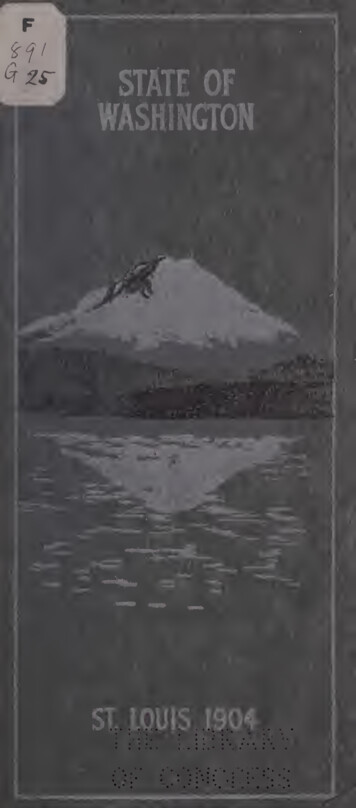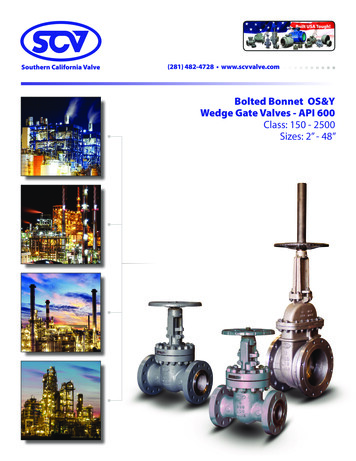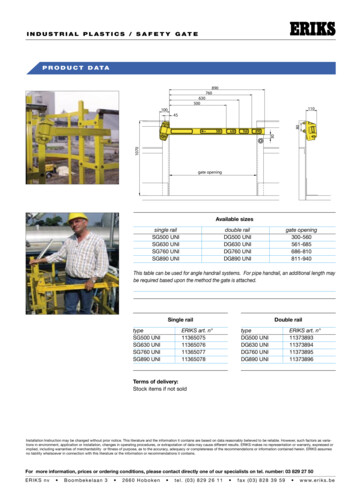
Transcription
* « **ct *c 4 e «
3ress.State z0):9
WASHINGTONHas the finest scenery on the Continent.Has the only arsenic refining plant in the Union.Cans more salmon than any other state in the Union.Has the largest single warehouse of any state in the Union.Has more standing timber than any other state in the UnionHas more excellent harbors than any other state in the UnioHas one town that ships more wheat than any other point inUnion.Manufactures more lumber and shingles than any other statthe Union.Produces more wheat and oats to the acre than any otherin the Union.Has the most extensive beds of decorative marble of anyin the Union.Has forest reserves containing more standing timber thanother state in the Union.Dispatches from her norts the two largest freighters afloat—Minnesota and the Dakota.Offers more opportunities to settlers and investors than any ostate in the Union.Maintains more fish hatcheries and turns out more spawnany other state in the Union.Has an equable climate, fine scenery and an abundance of gmaking it a paradise for the sportsmen.
TT With all the endowments of Nature to the state of Washington.,sin, Michigan and Minnesota depleted, the trade must turn to thenone are greater than its vast forests of cedar, fir, spruce,Pacific Northwest for its lumber and shingles.hemlock, larch, pine, etc., an endowment which is fully appre tent of the timber of Washington may be gained from the statementSome idea of the ex ciated by man, for he has sought to turn it into the channels ofthat the geological survey estimates now standing 195,237,000,000commerce, and as a result has made the state of Washington, sofeet, which would last for one hundred years with an annual cut ofyoung in years that by many it is supposed to be the home of thetwo billion feet.Indian and the “dime novel” westerner, the first of all the statesof this Union in the manufacture of lumber and shingles.EvenThe timber of the Pacific Northwest is noted for its size andstrength.Here the regulation log cut and prepared for the mills iswith this, so great are the timber resources of the stale that the in from two to four feet in diameter, while trees as large as nine anddustry is still in its infancy.ten feet are to be seen in nearly every large boom. Some idea of theThe forests have, to date, been simplynibbled around the edges. The great body yet remains and ’tis welllumber in a tree of this kind is furnished by the fact that a singlefor the country at large that it does, for with the forests of Wiscon tree has yielded 80,000 feet of lumber, enough to build complete,
THE4STATEOFWASHINGTONtrees.As they are required they are felled and findtheir way through the booms to the great band saw,and thence to the consumer.The fir of Washington, known as the Douglas fir, hasno equal among the timbers of the world in the varietyof uses to which it can be put.According to govern mental tests, it is stronger than oak.Tall, straight asan arrow, without a limb for a hundred feet, it is fur nishing spars and masts for all the world.The sparsand masts of The Defender, the cup winner last year,were of Washington fir. It has proven valuable in rail shingles and all, seven five-room cottages, leaving sufficient in theroad work, in car building for sills and finishing, and in bridge andshape of wood from the slabs and limbs to last the families living instructural work where great length, with strength, is necessary.these houses about a year.The great trees of Washington are becoming famed and year afterNext in importance to the fir is the cedar, from which is manu factured the celebrated Washington shingle, now known in everyyear are attracting the sightseer who has been led to believe thatlumber market.there are no big trees in this country save the giants of California,expands nor cold contracts, it is welcome everywhere.which, be it told, are well guarded, and are not trees attacked by theshingle business is still an "infant industry,” last year Washingtonlogger and the millman.manufactured more shingles than any other state.The giants of Washington are commercialSo perfect is this shingle, so firm that neither heatWhile the
THESTATEOFIt may be of interest to those making this line a study to have5WASHINGTONkinds of woodenware.The state has now ninety-one concernsbefore them a few figures which tell stories far greater than words,manufacturing sash and doors, furniture, pails, tubs, boxes, crates,stories that seem like fiction and yet which are proven facts.panels and fancy mill work.The following table gives the standing timber of the state:Their product has more than a localdemand, much of it going to the middle west states, many factoriesmaintaining eastern offices at Minneapolis, Omaha, Chicago, St.SpeciesFeet, B. M.Red Fir.Hemlock .Cedar.Yellow Pine.Ambilis Fir .Spruce .Larch.White Fir .Other ouis and Kansas City, and two or three a New York selling office.Eastern Washington is best known for its pine, and although it isthe west side where are located the larger and greater number ofmills, the entire state has made much of its timber resources.In the state are operated 419 lumber mills and 441 shingle mills,he former with a daily capacity of 26,000,000 feet, and the latter12,000,000 shingles. Within the state are operated over 300 loggingcamps.)00,000.The spruce in Washington is numbered among the trees that havegrown to great size. This wood is white, resembling pine, and beingThe mills, logging camps and woodenware manufacturingplants pay to wage earners during a single year in excess of 25,Over 37,000,000 is employed in lumbering.Last yearWashington shipped by rail 42,701 cars of lumber and 35,764 carsf shingles, while the cargo trade was 770,057,846 feet, or measuredof light weight, is used for all kinds of boxes, woodenware and fur in cars, about twenty per cent more than by rail.niture.ber goes to nearly every country on the Pacific, and a great deal toThe hemlock finds a similar use.The existence of suchmaterial has naturally resulted in large manufacturing plants for allhe European countries.This cargo lum Australia and South Africa are also great
' )iNNEP(jrt)ELLS CO.
THEconsumers.STATEOFWASHINGTONThe cargo trade of 1903 was a gain over 1902of 34.7 per cent while there was a gain in rail shipmentsof 13.2 per cent.The shipment of shingles by water is, asyet, not so extensive as by rail, but each year sees it grow.The significance of these figures is better understood whenit is stated that had all the lumber and shingles manufacturedin Washington during 1903 been placed on cars and all thecars made into one train, that train would have reachedfrom Puget Sound to St. Paul.There still remains much timber land subject to entry.FOR THE WASHINGTON STATE BUILDING.
8THE STATE OF WASHINGTONA FEW SHINGLE FACTS.WASHINGTON to-day ranks FIRST among states in theproduction of shingles.WASHINGTON has a stumpage of 22,646,071,000 feet.WASHINGTON has 441 shingle mills.These mills have a daily capacity of 42,000,000 shingles.WASHINGTON last year shipped by rail 5,722,240,000,or 35,764 car loads, of shingles.WASHINGTON lastyear shipped by . boat 60,000,000shingles.The shingle mills of WASHINGTON last year paid theiremployees 2,800,000.
flax, etc. As these mount ains slope to the Columbia river,which broad and magnificent stream nursesthese same wheat fields, there is a great stretch oflight soil, referred to as arid, and yet which bloomsand blossoms as did the fabled gardens of the Aztec Gods,when supplied with water.It is a land of eternal sunshine.High ! the mountains, carefully guarded by giant snow-clad peaks, are: irge lakes proud of their hoarded stores of water, which throughhe intervention of man, with his numerous irrigation canals, furnishthroughout the year a steady and reliable supply of moisture, thusMJT Nature modeled the State of Washington after plans furnishedby the Goddess of Plenty, who here sought to form a landwherethetillerof thesoilandthegathererofgrainnabling the soil to enrich the world with its latent powers.As the western slope of the mountains dips down to the sea are lowlands of rich alluvial soil.Here are to be found thousands of smallmight live happily, peacefully and with every want of life supplied.alleys where the grass is always green, where stock grazes in theHence it is that on the east side of the mountains are to be foundeld the year round, and where twenty acres of land devoted to fruit,great broad and rolling prairies, the soil of which gladdens theheart of the farmer by producing prodigiously of wheat, barley, rye,egetables or dairying will keep a family in plenty.Although some distance north the gentle winds from the ocean,
10THE STATE OF WASHINGTONcountry” and the "Walla Walla country.”The former two, com prising the greater part of eastern Washington, are primarily wheatproducing sections, while the latter, famed also for its wheat, islikewise famed for its fruits.rich.The soil of these districts is deep andOf volcanic origin, each passing century has deposited upon itdecaying matter which teems with all the elements required in a soilto produce hardy grains, and to be almost everlasting.is needed.The raw land is ready for the plow.bring big returns.No fertilizerThe first crop willFrom twenty-five to fifty bushels of wheat per acrewill be the result, with every facility for marketing, while goodprices always prevail.At first glance the farmer fiom level sections of the east or middlewest doubts the ability of these rolling hills to produce.at the manner of farming.great gang plows.He marvelsPlowing is done almost entirely withIn many instances a string of ten to twenty fol low a great traction engine.Wheat is harvested largely by the head er, the grain going directly from the header box to the threshercylinder.Often a combined machine is used—a header and threshertempered by the warm Japan current, sweep across these lands andall in one — and the grain, in sacks, deposited behind the machine asfar up into the mountains, keeping that section of Washington lyingit rolls along, is ready for the market.west of the Cascades at an even and desirable temperature all theyear.But the Goddess of Plenty, seeking also the protectiont herThe careful farmers, and those who have given the matter con siderable study, estimate that wheat can be raised in eastern Wash great wheat fields from the chilling blasts of the north, tore down theington and marketed for twenty-six cents per bushel.barriers of the snow clad mountains to make road for the Columbiamind you, with the average yield about thirty bushels per acre.river, leaving a wide channel for these same warm winds to carryThe large farms are being cut up into smaller tracts.their tempering breaths to the eastern section of the state, where,farming in this section is coming into vogue.save the high altitudes, the winter is like Virginia or Maryland.depends upon his wheat alone.The great rolling prairies of eastern Washington are commonlydivided into three sections — the “ Big Bend country,” the " P,douseAnd this,DiversifiedThe farmer no longerHe now has his little orchard, hishogs, his cattle and his chickens, from all of which he gets goodreturns.Much new land is being opened up.The wheat section of
THESTATEA Combined Harvester in Action.{fspi?!A combined Harvester.HEADINGOFWASHINGTON11
THE12STATEOFWASHINGTONthe state is being made to produce more than formerly and the landWest of the Cascade mountains there is no small amount of farm over which, but a few years ago, ranged the cattle and horses of theing.Indians, is today cut into profitable farms, with neat and comfortableWashington because of the moisture, and here, as in the irrigatedhouses, and every sign of prosperity such as makes the Goddess ofsections, small tracts are the rule.Plenty smile with supreme satisfaction when she sees thus carriedvegetables, hay, oats or dairying and in each, or in all, has found aout by man her complete plans so well modeled by nature.The soil is not so well adapted to wheat as that of easternprofit.The farmer has gone into fruit,Where once grew the giant fir and cedar, which furnishedThe irrigated sections of Washington, being principally that partthe farmer of New England with shingles, or built for the merchantof the state along the east slope of the Cascade mountains, haveof Australia his dwelling, is now the prosperous farmer who foundproven garden spots.soil so rich and deep that upon twenty acres he could live handsome Man has brought the water from the lakesin the mountains to the fields of each land owner, that his crops mayly.be supplied as nature requires.both the demand is constantly increasing.These sections are famous for theirfruit, vegetables, hops and alfalfa.Small farms are the rule, forFruit and dairying are here the principal industries, and forSome are devoting muchattention to oats, which here grow more profusely than in other sec upon ten acres a man can support comfortably a good sized familytions of the United States.and find his ) early balance of cash in the bank constantly increasing.on these low lands is not unusual.A record of a hundred bushels to the acreDemand for oats is always great.—an Inland Flour MilHaulingLoading11ifor the orientLU17-J.wheat to warehouse.
THE STATE OF WASHINGTON13HOPS OF WASHINGTON GROWTH have their virtues sungthat new and large fields are being put in each year.in every brewing center of the United States, and their virtuessection of the Union offering more opportunities for hop growingare many.than Washington.It was practically but a few years ago when theThere is noThere are yet thousands of acres of valleyfarmers found the small valleys of western Washington especiallylands especially adapted to hops, that now serve no other purposeadapted to hops, and the growing of the same was first taken up inthan a field for the sportsman seeking game.rather an experimental way.They grew, and grew profuse ly, and being found to contain many qualities lackingin hops of other sections, lands covered withstumps were cleared off and put into hops.The buyers from east and south were notslow to recognize the value of the Washing ton product, and those who were able to se cure a large consignment considered themselvesfortunate indeed.in price.This land is not highCleared of the underbrush, and with little labor andsmall expense, the grower will soon find himself theundisputed owner of a field that will yearlyproduce him an excellent return for moneyexpended, enabling him to live like a king,and be independent of everyone.Washington hops the past season have broughta price of from twenty-five to thirty cents perpound.The demand has been steady.TheThe hop sections of Washington can be saidOrient, which has taken to American beer,to be confined to the valleys of western Wash makes an increased demand for that productington, and to the Yakima country in centraland hence an increased demand for hops.While they can be raised toThere is little likelihood, present conditionsprofit in other sections, it is in the aboveprevailing, of there being any decrease in thenamed that the growing is extensive, and theredemand or price for many years to come.Washington.\
THE STATE OF WASHINGTON14EFT without the vast ranges of years ago, Washington is yet a statenoted for its live stock — its horses, its sheep and its cattle.Whilethe broad and fertile prairies over which formerly roamed greatherds have been turned by the energetic settler into rich wheatfields and productive orchards,the agriculturist has not yetr rrrrmrrTr/ 7’/ jxszyv/s vr/rYJ-/Z2TznLreached the many mountain valleys and broad plateaus, and hencehere is found feed for the great bands of cattle, sheep and horses.The east slope of the Cascade mountains affords, at this time, thebest ranges, and the sheep as well as the cattle industry hasreached large proportions.The demand for cattle for the pack ing houses of the coast is ever increasing.In Seattle, Tacoma,Everett, Bellingham and Spokane are to be found these packinghouses, and even with the amount of stock now available, theseestablishments are unable to secure enough to satisfy the demandsof the trade.the Orient.This product goes to the mines, to Alaska and toThe sheep ranges, while becoming smaller each year,are yet large enough to permit of the pasturing of great bands.The range horse has practically disappeared.Today the horse man breeds for a determined market, and to do so handles hisanimals carefully and in pastures.The demand for horses includesnot only the draft horse but the finest bred driving and fancy stock.
THESTATEOFAIRYING in Washington now takes afront rank among the leading andmost profitable lines for people ofsmall means.It is carried on innearly every section of the state, butthe low lands and small rich valleyswest of the Cascade mountains affordthe best opportunities for those seek ing to engage in it.Here the grassis green all the year.Land uponwhich the timber was once dense,after being logged off, proves espec ially adapted to grasses, clover andalfalfa, and hence a small tract will provide fodder for a largenumber of dairy cows.is large.The demand for all kinds of dairy productsAlaska calls for much butter and condensed; milk, whilethe trade in butter, cheese and condensed milk with the Orient hasincreased remarkably in the past few years.This trade, just open ing up, will afford a ready and profitable market for the product ofmillions of Washington cows.The local demand is far greater thanthe local supply, and will be for many years.The average whole sale price of butter for the past year was thirty cents a pound.Theaverage cost of producing and marketing the same is fully forty percent less than in eastern butter centers.During 1903 352 creamer-es operating in the state of Washington produced 6,970,992 poundsof butter while the local demand, exclusive of the Alaska demandand export trade, was over 16,000,000 pounds.OS'3PA Largecreamery.WASHINGTON15
THE16STATEOF WASHINGTONJ RUIT growing in Washington1has proven a most profitableoccupation for the industriousman of small means.The re-Snake rivers to almost semihas enabled the horticulturisthere to raise all kinds of fruit' on fiOLLM.tion join to aid him in the labor,deep alluvial soil of the Colum bia and Snake river valleys, togetherwith the low lands of other sections of the eastern part of thestate has enabled the small farmers here to raise apples, peaches,pears and all kinds of berries in abundance and to great profit.The irrigated sections of central Washington are, perhaps, thebest known as fruit lands, for here fruit raising is the leadingpursuit, and the great red apples of Wenatchee and the Yakimacountry are known in every market of the middle west.On thewest side of the mountains, in the many rich valleys, is grown, notonly all kinds of fruit, but here the berry industry takes frontrank, and has proven a most profitable field.t n r*iAKing of OrchardBranchof Cherries.oneDOLLARONEDOLLAR
THE STATE OF WASHINGTONA Two Year OiTd Pear TrhPicking* Applet17m *.*
THE18RRIGATIONSTATEhas ousands of acres of land in thestate, through the means of irrigat Snake River ValleyBefore Irrigation.ing ditches, have been made to giveforth to enrich man the very bestproduced in fruits, vegetables andforage grasses.These reclaimedlands are, today, proving the mostdesirable fruit lands on the conti nent.From a few acres a man isable to make a comfortable livingfor himself and family. A land of continual’'sunshine, with suchsupply of moisture at his; door' as. occasion may require, it takesnothing, save energy and care, to secure trom a ten- or twentyacre tract, two, three, or four thousand dol
In the state are operated 419 lumber mills and 441 shingle mills, he former with a daily capacity of 26,000,000 feet, and the latter 12,000,000 shingles. Within the state are operated over 300 logging camps. The mills, logging camps and woodenware manufacturing plants pay to wage










